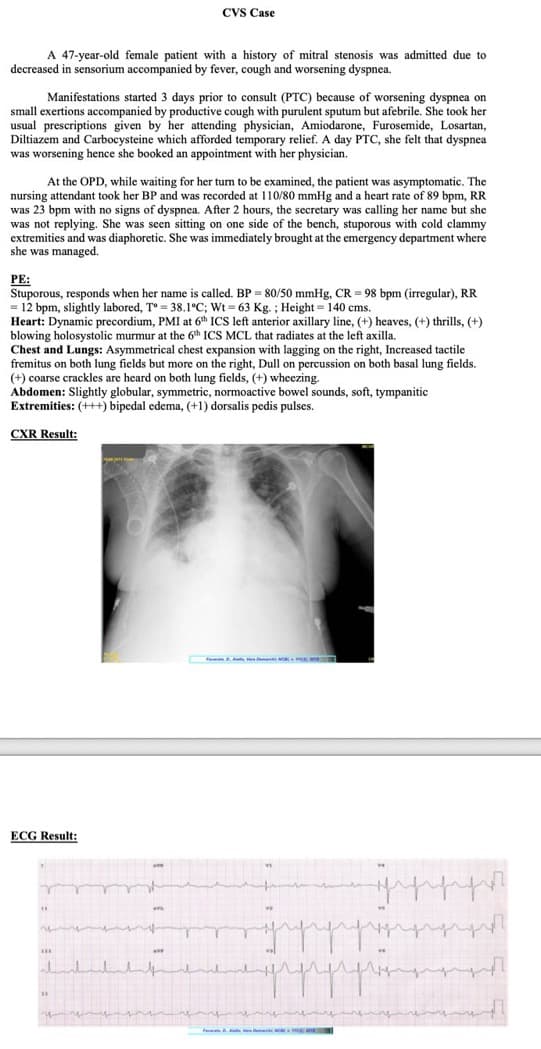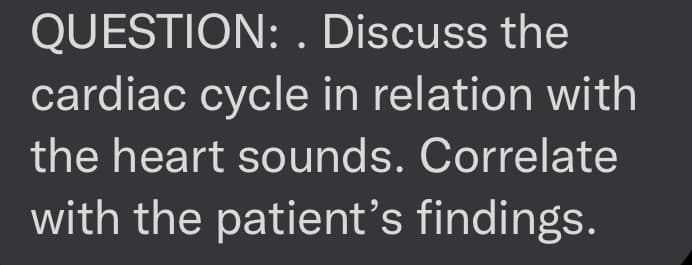A 47-year-old female patient with a history of mitral stenosis was admitted due to decreased in sensorium accompanied by fever, cough and worsening dyspnea. Manifestations started 3 days prior to consult (PTC) because of worsening dyspnea on small exertions accompanied by productive cough with purulent sputum but afebrile. She took her usual prescriptions given by her attending physician, Amiodarone, Furosemide, Losartan, Diltiazem and Carbocysteine which afforded temporary relief. A day PTC, she felt that dyspnea was worsening hence she booked an appointment with her physician. CVS Case At the OPD, while waiting for her turn to be examined, the patient was asymptomatic. The nursing attendant took her BP and was recorded at 110/80 mmHg and a heart rate of 89 bpm, RR was 23 bpm with no signs of dyspnea. After 2 hours, the secretary was calling her name but she was not replying. She was seen sitting on one side of the bench, stuporous with cold clammy extremities and was diaphoretic. She was immediately brought at the emergency department where she was managed. PE: Stuporous, responds when her name is called. BP = 80/50 mmHg, CR = 98 bpm (irregular), RR = 12 bpm, slightly labored, T° = 38.1°C; Wt = 63 Kg.; Height = 140 cms. Heart: Dynamic precordium, PMI at 6th ICS left anterior axillary line, (+) heaves, (+) thrills, (+) blowing holosystolic murmur at the 6th ICS MCL that radiates at the left axilla. Chest and Lungs: Asymmetrical chest expansion with lagging on the right, Increased tactile fremitus on both lung fields but more on the right, Dull on percussion on both basal lung fields. (+) coarse crackles are heard on both lung fields, (+) wheezing. Abdomen: Slightly globular, symmetric, normoactive bowel sounds, soft, tympanitic Extremities: (+++) bipedal edema, (+1) dorsalis pedis pulses. CXR Result: ECG Result: ave FD. A NOR T m n 42 va www Hrv ppppp grap v4


Trending now
This is a popular solution!
Step by step
Solved in 2 steps

what are the factors that regulate net filtration pressure in the capillaries and what are its Correlation with patient’s findings.
A 30 year-old policeman is brought to the ER due to the bleeding from his abdomen from a gunshot wound injury. He feels light headed, palpatations and cold sweat. Uon examination, his heart rate is around 130 beats per minute while blood pressure is maintained at normal. His extremities were cold and clammy. An immediate blood transfusion was done and brought to the OR for an operation.
1. What would explain the symptoms of the patient?
2. Is this an example of a reflex? Why or why not?
3. How would you explain the blood pressure being maintained at the normal level?
3. If his BP goes down, what neurotransmitter is likely to be elevated?
Differentiate transport maxima and gradient-time limited transport in proximal tubule.
correlate the cardiac action potential with the normal ECG tracings. compare the patient's ECG tracing with the discussion
Discuss the factors that will affect cardiac output. Correlate with patient's findings.
Discuss the factors that will affect cardiac output. Correlate with the patient's findings
Discuss the factors that regulate net filtration pressure in the capillaries. Correlate with patient’s findings.
Differentiate the action potentials of the types of cardiac muscles. Correlate with the patient’s
findings







